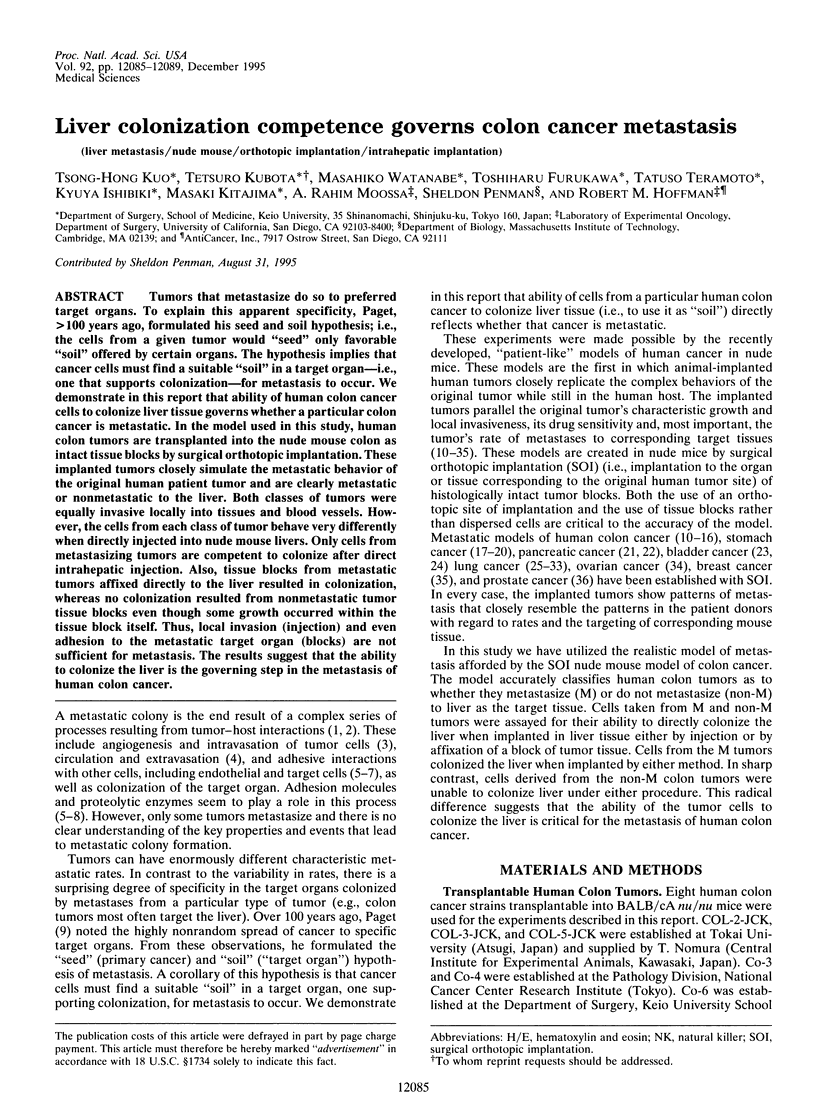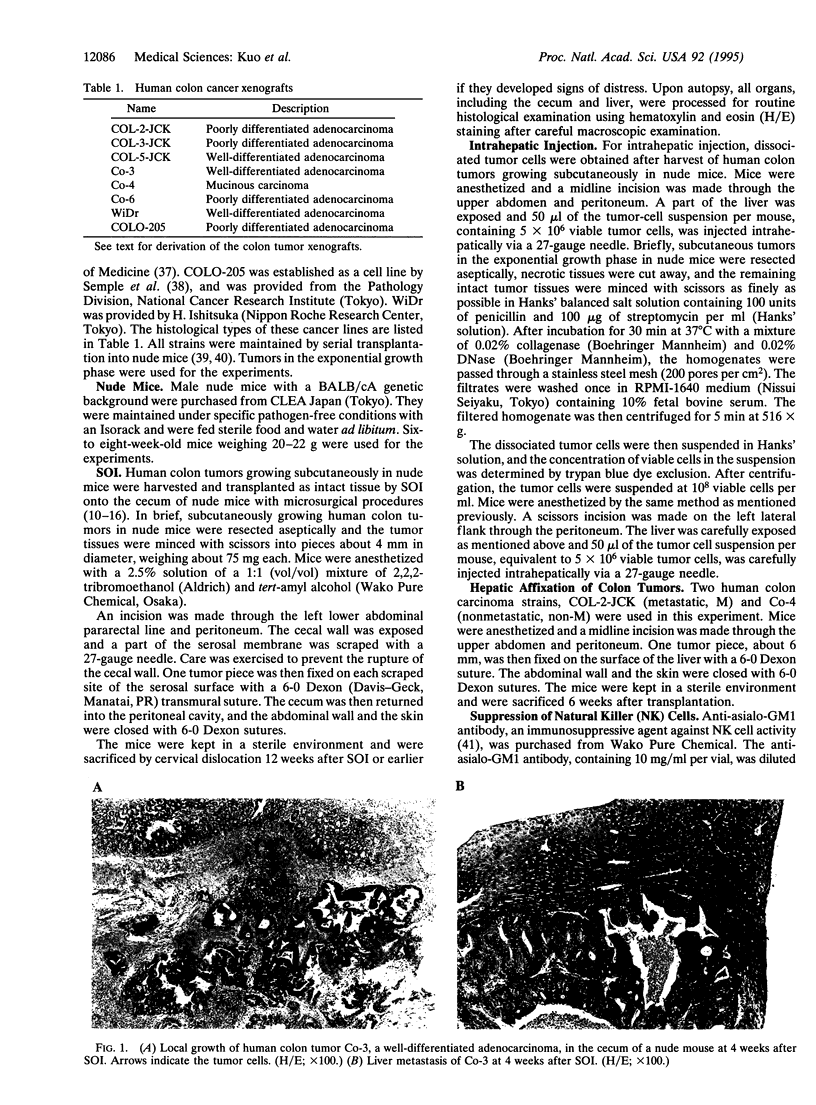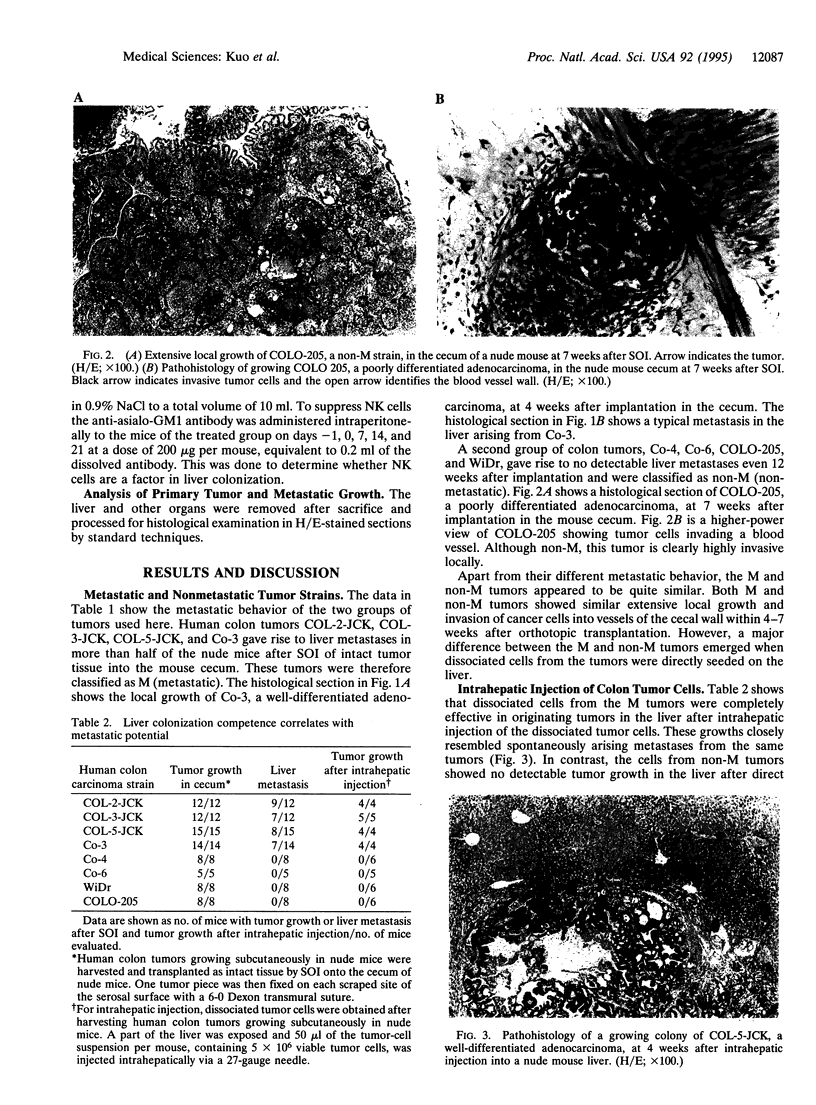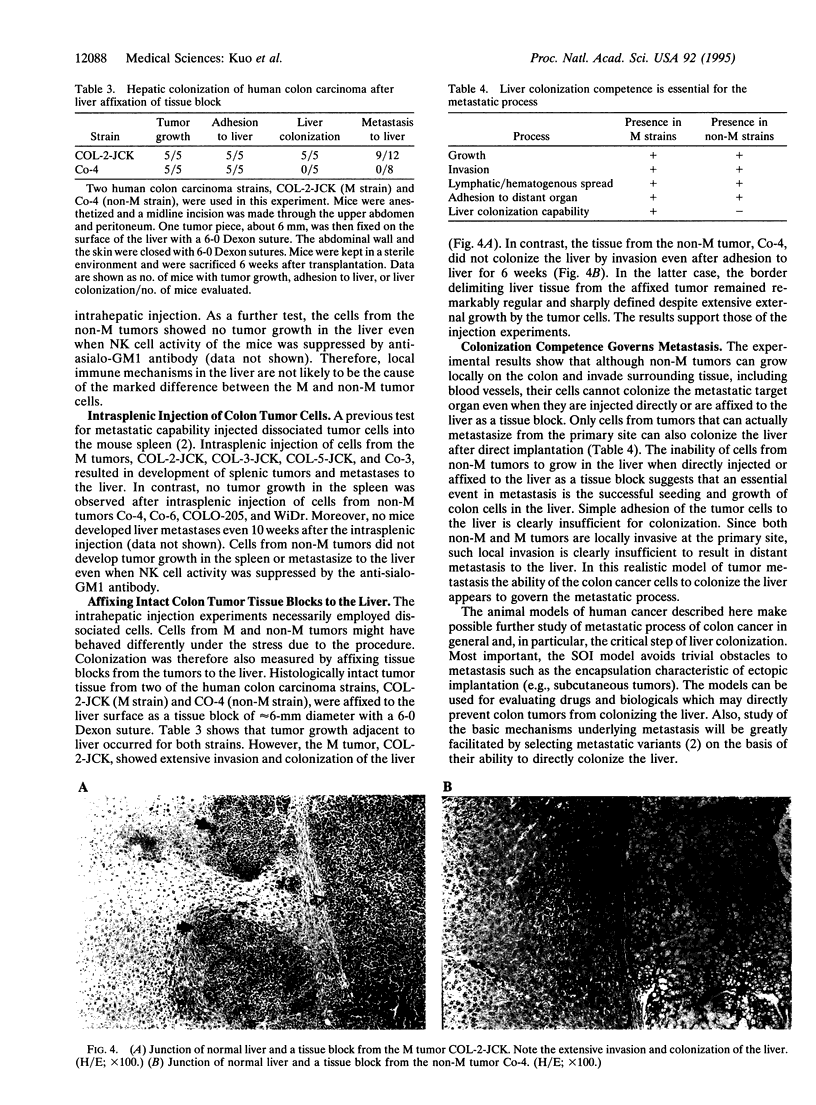Abstract
Tumors that metastasize do so to preferred target organs. To explain this apparent specificity, Paget, > 100 years ago, formulated his seed and soil hypothesis; i.e., the cells from a given tumor would "seed'' only favorable "soil'' offered by certain groups. The hypothesis implies that cancer cells must find a suitable "soil'' in a target organ--i.e., one that supports colonization--for metastasis to occur. We demonstrate in this report that ability of human colon cancer cells to colonize liver tissue governs whether a particular colon cancer is metastatic. In the model used in this study, human colon tumors are transplanted into the nude mouse colon as intact tissue blocks by surgical orthotopic implantation. These implanted tumors closely simulate the metastatic behavior of the original human patient tumor and are clearly metastatic or nonmetastatic to the liver. Both classes of tumors were equally invasive locally into tissues and blood vessels. However, the cells from each class of tumor behave very differently when directly injected into nude mouse livers. Only cells from metastasizing tumors are competent to colonize after direct intrahepatic injection. Also, tissue blocks from metastatic tumors af fixed directly to the liver resulted in colonization, whereas no colonization resulted from nonmetastatic tumor tissue blocks even though some growth occurred within the tissue block itself. Thus, local invasion (injection) and even adhesion to the metastatic target organ (blocks) are not sufficient for metastasis. The results suggest that the ability to colonize the liver is the governing step in the metastasis of human colon cancer.
Full text
PDF




Images in this article
Selected References
These references are in PubMed. This may not be the complete list of references from this article.
- Astoul P., Colt H. G., Wang X., Hoffman R. M. A "patient-like" nude mouse model of parietal pleural human lung adenocarcinoma. Anticancer Res. 1994 Jan-Feb;14(1A):85–91. [PubMed] [Google Scholar]
- Astoul P., Colt H. G., Wang X., Hoffman R. M. Metastatic human pleural ovarian cancer model constructed by orthotopic implantation of fresh histologically-intact patient carcinoma in nude mice. Anticancer Res. 1993 Nov-Dec;13(6A):1999–2002. [PubMed] [Google Scholar]
- Fidler I. J. Critical factors in the biology of human cancer metastasis: twenty-eighth G.H.A. Clowes memorial award lecture. Cancer Res. 1990 Oct 1;50(19):6130–6138. [PubMed] [Google Scholar]
- Fu X. Y., Besterman J. M., Monosov A., Hoffman R. M. Models of human metastatic colon cancer in nude mice orthotopically constructed by using histologically intact patient specimens. Proc Natl Acad Sci U S A. 1991 Oct 15;88(20):9345–9349. doi: 10.1073/pnas.88.20.9345. [DOI] [PMC free article] [PubMed] [Google Scholar]
- Fu X. Y., Theodorescu D., Kerbel R. S., Hoffman R. M. Extensive multi-organ metastasis following orthotopic onplantation of histologically-intact human bladder carcinoma tissue in nude mice. Int J Cancer. 1991 Dec 2;49(6):938–939. doi: 10.1002/ijc.2910490623. [DOI] [PubMed] [Google Scholar]
- Fu X., Guadagni F., Hoffman R. M. A metastatic nude-mouse model of human pancreatic cancer constructed orthotopically with histologically intact patient specimens. Proc Natl Acad Sci U S A. 1992 Jun 15;89(12):5645–5649. doi: 10.1073/pnas.89.12.5645. [DOI] [PMC free article] [PubMed] [Google Scholar]
- Fu X., Herrera H., Hoffman R. M. Orthotopic growth and metastasis of human prostate carcinoma in nude mice after transplantation of histologically intact tissue. Int J Cancer. 1992 Dec 2;52(6):987–990. doi: 10.1002/ijc.2910520626. [DOI] [PubMed] [Google Scholar]
- Fu X., Herrera H., Kubota T., Hoffman R. M. Extensive liver metastasis from human colon cancer in nude and scid mice after orthotopic onplantation of histologically-intact human colon carcinoma tissue. Anticancer Res. 1992 Sep-Oct;12(5):1395–1397. [PubMed] [Google Scholar]
- Fu X., Hoffman R. M. Human RT-4 bladder carcinoma is highly metastatic in nude mice and comparable to ras-H-transformed RT-4 when orthotopically onplanted as histologically intact tissue. Int J Cancer. 1992 Jul 30;51(6):989–991. doi: 10.1002/ijc.2910510625. [DOI] [PubMed] [Google Scholar]
- Fu X., Hoffman R. M. Human ovarian carcinoma metastatic models constructed in nude mice by orthotopic transplantation of histologically-intact patient specimens. Anticancer Res. 1993 Mar-Apr;13(2):283–286. [PubMed] [Google Scholar]
- Fu X., Le P., Hoffman R. M. A metastatic orthotopic-transplant nude-mouse model of human patient breast cancer. Anticancer Res. 1993 Jul-Aug;13(4):901–904. [PubMed] [Google Scholar]
- Furukawa T., Fu X., Kubota T., Watanabe M., Kitajima M., Hoffman R. M. Nude mouse metastatic models of human stomach cancer constructed using orthotopic implantation of histologically intact tissue. Cancer Res. 1993 Mar 1;53(5):1204–1208. [PubMed] [Google Scholar]
- Furukawa T., Kubota T., Watanabe M., Kitajima M., Hoffman R. M. A novel "patient-like" treatment model of human pancreatic cancer constructed using orthotopic transplantation of histologically intact human tumor tissue in nude mice. Cancer Res. 1993 Jul 1;53(13):3070–3072. [PubMed] [Google Scholar]
- Furukawa T., Kubota T., Watanabe M., Kitajima M., Hoffman R. M. Orthotopic transplantation of histologically intact clinical specimens of stomach cancer to nude mice: correlation of metastatic sites in mouse and individual patient donors. Int J Cancer. 1993 Feb 20;53(4):608–612. doi: 10.1002/ijc.2910530414. [DOI] [PubMed] [Google Scholar]
- Furukawa T., Kubota T., Watanabe M., Kuo T. H., Kase S., Saikawa Y., Tanino H., Teramoto T., Ishibiki K., Kitajima M. Immunochemotherapy prevents human colon cancer metastasis after orthotopic onplantation of histologically-intact tumor tissue in nude mice. Anticancer Res. 1993 Mar-Apr;13(2):287–291. [PubMed] [Google Scholar]
- Furukawa T., Kubota T., Watanabe M., Kuo T. H., Kitajima M., Hoffman R. M. Differential chemosensitivity of local and metastatic human gastric cancer after orthotopic transplantation of histologically intact tumor tissue in nude mice. Int J Cancer. 1993 May 28;54(3):397–401. doi: 10.1002/ijc.2910540308. [DOI] [PubMed] [Google Scholar]
- Furukawa T., Kubota T., Watanabe M., Nishibori H., Kuo T. H., Ishibiki K., Kitajima M. [A metastatic model of human gastric cancers using orthotopic tissue implantation in nude mice: preliminary report]. Nihon Geka Gakkai Zasshi. 1992 May;93(5):561–561. [PubMed] [Google Scholar]
- Habu S., Fukui H., Shimamura K., Kasai M., Nagai Y., Okumura K., Tamaoki N. In vivo effects of anti-asialo GM1. I. Reduction of NK activity and enhancement of transplanted tumor growth in nude mice. J Immunol. 1981 Jul;127(1):34–38. [PubMed] [Google Scholar]
- Hynes R. O. Integrins: versatility, modulation, and signaling in cell adhesion. Cell. 1992 Apr 3;69(1):11–25. doi: 10.1016/0092-8674(92)90115-s. [DOI] [PubMed] [Google Scholar]
- Kase S., Kubota T., Furukawa T., Yamaguchi H., Takeuchi T., Takahara T., Suto A., Kodaira S., Ishibiki K. [Establishment of transplantable human colon cancer cell lines, chemosensitivity of colon carcinomas and the serially transplantable strains with MTT assay]. Gan To Kagaku Ryoho. 1991 Oct;18(13):2247–2253. [PubMed] [Google Scholar]
- Kuo T. H., Kubota T., Watanabe M., Furukawa T., Kase S., Tanino H., Nishibori H., Saikawa Y., Teramoto T., Ihsibiki K. Orthotopic reconstitution of human small-cell lung carcinoma after intravenous transplantation in SCID mice. Anticancer Res. 1992 Sep-Oct;12(5):1407–1410. [PubMed] [Google Scholar]
- Kuo T. H., Kubota T., Watanabe M., Furukawa T., Kase S., Tanino H., Saikawa Y., Ishibiki K., Kitajima M., Hoffman R. M. Site-specific chemosensitivity of human small-cell lung carcinoma growing orthotopically compared to subcutaneously in SCID mice: the importance of orthotopic models to obtain relevant drug evaluation data. Anticancer Res. 1993 May-Jun;13(3):627–630. [PubMed] [Google Scholar]
- Kuo T. H., Kubota T., Watanabe M., Furukawa T., Teramoto T., Ishibiki K., Kitajima M., Hoffman R. M. Early resection of primary orthotopically-growing human colon tumor in nude mouse prevents liver metastasis: further evidence for patient-like hematogenous metastatic route. Anticancer Res. 1993 Mar-Apr;13(2):293–297. [PubMed] [Google Scholar]
- Lapis K., Paku S., Liotta L. A. Endothelialization of embolized tumor cells during metastasis formation. Clin Exp Metastasis. 1988 Jan-Feb;6(1):73–89. doi: 10.1007/BF01580408. [DOI] [PubMed] [Google Scholar]
- Liotta L. A., Kleinerman J., Saidel G. M. Quantitative relationships of intravascular tumor cells, tumor vessels, and pulmonary metastases following tumor implantation. Cancer Res. 1974 May;34(5):997–1004. [PubMed] [Google Scholar]
- Liotta L. A., Stetler-Stevenson W. G., Steeg P. S. Cancer invasion and metastasis: positive and negative regulatory elements. Cancer Invest. 1991;9(5):543–551. doi: 10.3109/07357909109018952. [DOI] [PubMed] [Google Scholar]
- Nakajima M., Morikawa K., Fabra A., Bucana C. D., Fidler I. J. Influence of organ environment on extracellular matrix degradative activity and metastasis of human colon carcinoma cells. J Natl Cancer Inst. 1990 Dec 19;82(24):1890–1898. doi: 10.1093/jnci/82.24.1890. [DOI] [PubMed] [Google Scholar]
- Ruoslahti E. Integrins. J Clin Invest. 1991 Jan;87(1):1–5. doi: 10.1172/JCI114957. [DOI] [PMC free article] [PubMed] [Google Scholar]
- Semple T. U., Quinn L. A., Woods L. K., Moore G. E. Tumor and lymphoid cell lines from a patient with carcinoma of the colon for a cytotoxicity model. Cancer Res. 1978 May;38(5):1345–1355. [PubMed] [Google Scholar]
- Shimosato Y., Kameya T., Nagai K., Hirohashi S., Koide T., Hayashi H., Nomura T. Transplantation of human tumors in nude mice. J Natl Cancer Inst. 1976 Jun;56(6):1251–1260. doi: 10.1093/jnci/56.6.1251. [DOI] [PubMed] [Google Scholar]
- Taraboletti G., Belotti D., Giavazzi R., Sobel M. E., Castronovo V. Enhancement of metastatic potential of murine and human melanoma cells by laminin receptor peptide G: attachment of cancer cells to subendothelial matrix as a pathway for hematogenous metastasis. J Natl Cancer Inst. 1993 Feb 3;85(3):235–240. doi: 10.1093/jnci/85.3.235. [DOI] [PubMed] [Google Scholar]
- Togo S., Shimada H., Kubota T., Moossa A. R., Hoffman R. M. Host organ specifically determines cancer progression. Cancer Res. 1995 Feb 1;55(3):681–684. [PubMed] [Google Scholar]
- Wang X., Fu X., Brown P. D., Crimmin M. J., Hoffman R. M. Matrix metalloproteinase inhibitor BB-94 (batimastat) inhibits human colon tumor growth and spread in a patient-like orthotopic model in nude mice. Cancer Res. 1994 Sep 1;54(17):4726–4728. [PubMed] [Google Scholar]
- Wang X., Fu X., Hoffman R. M. A new patient-like metastatic model of human lung cancer constructed orthotopically with intact tissue via thoracotomy in immunodeficient mice. Int J Cancer. 1992 Jul 30;51(6):992–995. doi: 10.1002/ijc.2910510626. [DOI] [PubMed] [Google Scholar]
- Wang X., Fu X., Hoffman R. M. A patient-like metastasizing model of human lung adenocarcinoma constructed via thoracotomy in nude mice. Anticancer Res. 1992 Sep-Oct;12(5):1399–1401. [PubMed] [Google Scholar]
- Wang X., Fu X., Kubota T., Hoffman R. M. A new patient-like metastatic model of human small-cell lung cancer constructed orthotopically with intact tissue via thoracotomy in nude mice. Anticancer Res. 1992 Sep-Oct;12(5):1403–1406. [PubMed] [Google Scholar]






